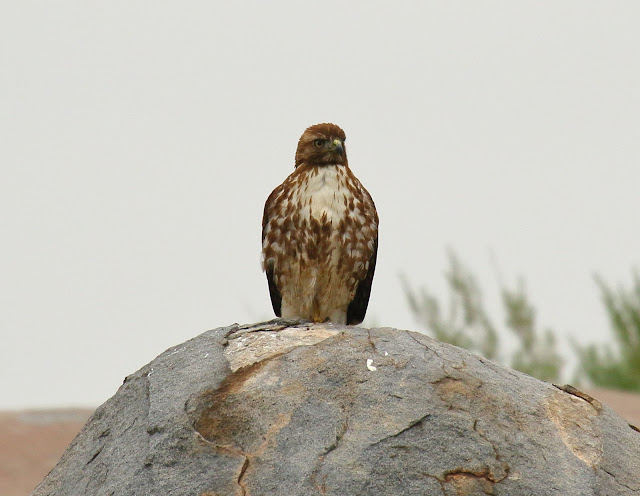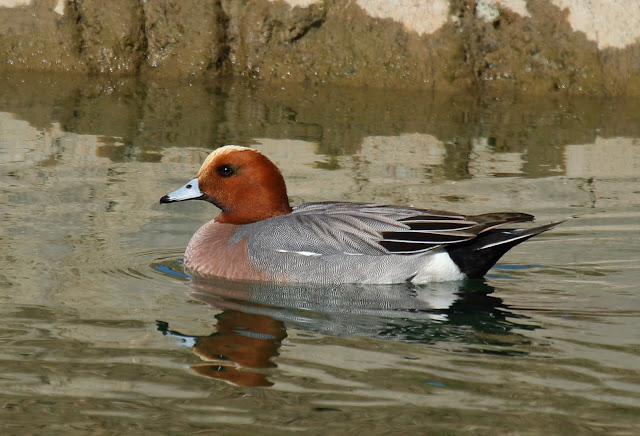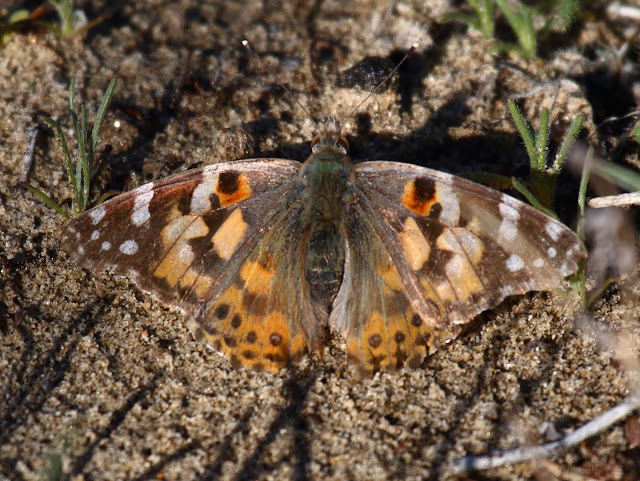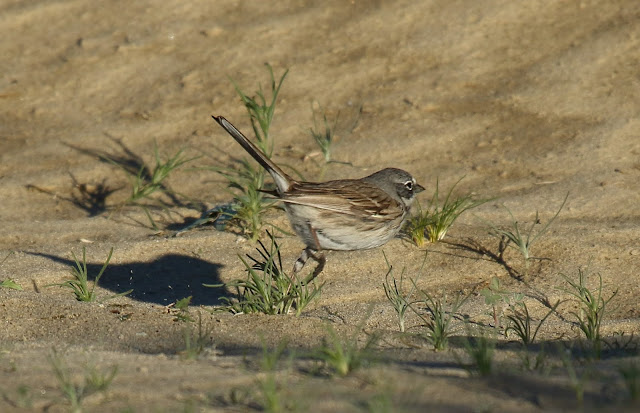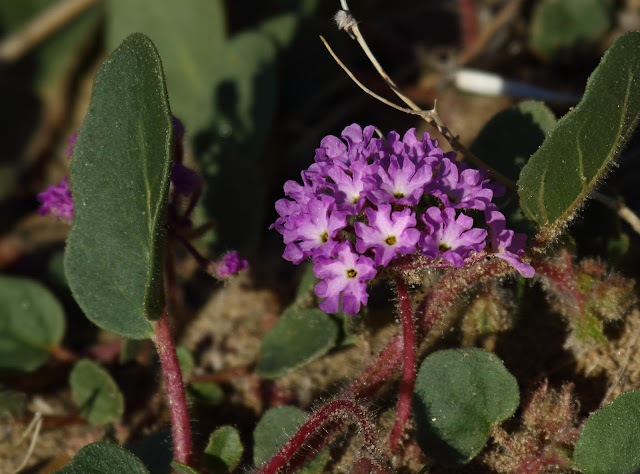It has only been 2 years since the last
"super bloom" in 2017.
It's been a cool, rainy winter in San Diego County, even in the Anza-Borrego Desert on the "dry" side of the mountains. As a result, many were predicting another "super bloom"--a spring wildflower show brought on by more than average winter rains.
Marlene and I visited in February and made arrangements to come back at the same time we were here in 2017. We spent the long weekend of March 16-18, 2019 in the Anza-Borrego Desert. The first morning we visited birding locations in the south end of the desert. We arrived in Borrego Springs in the north on Saturday afternoon and stayed until noon Monday.
 |
Borrego Springs wildflowers, Borrego Springs Road near Henderson Canyon Road. March 18, 2019.
|
Compared with 2017, the wildflowers are less intense, but more widespread, this year. In 2017 all the wildflowers were blooming during that one week of 90+F degree weather. This year wildflowers started in some protected south facing canyons in February. They were going strong during our mid-March visit, yet some flowers--like the Desert Lily--were mostly just buds. Out warmest day--and one of the warmest this year, thus far, was only 83F.
The long period of rainy weather has been especially conducive to growing grass--yes, the desert floor (between all the cactus and creosote) is a carpet of foot-high grass!
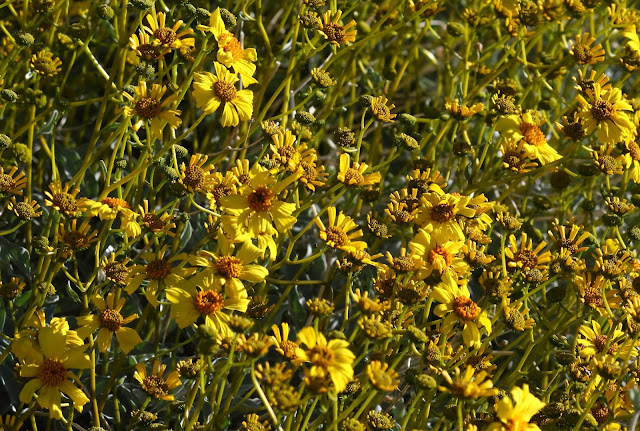 |
Rain or no, Brittlebush flowers tower over the blue-green leaves of this shrub every spring.
It is found in higher, rockier areas of the desert. This one was at Vallecito County Park.
|
My flower identification skills are barely at the dandelion, daffodil, rose, tulip stage. So I use the wonderfully handy foldable poster "Spring Wildflowers of Anza-Borrego Desert State Park." This 2005 publication lists over 50 species of wildflowers that pretty much include any species you are likely to see. It was still in print 2 years ago when I got mine. I noticed other people with this publication on the side of the road (reminding me of bygone ages where people navigated using impossible-to-refold paper maps).
 |
| About 6-8 inches tall are these Brown-eyed Primrose. |
 |
| This was a new flower for me, and widespread, the Wild Heliotrope, if I'm not mistaken. |
It seems this year there are more clumps of purple flowers than in 2017. I think they are Wild Heliotrope. I also saw a similar flower in the same genus (
Phacelia)--Scorpionweed. I could easily have them reversed. There is a third
Phacelia I did not identify: Wild Canterbury Bells.
 |
This pretty flower is about 6 inches tall. I have no idea what it is, though.
It was near the Borrego Springs waste treatment ponds.
It is surrounded by the tiny Popcorn Flower.
|
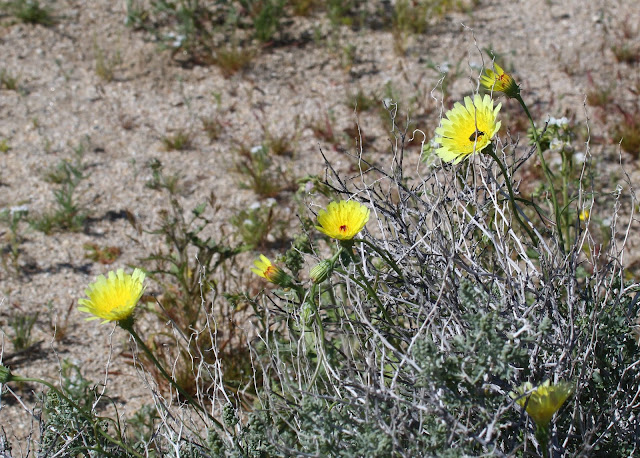 |
| Desert Dandelion was a widespread flower. |
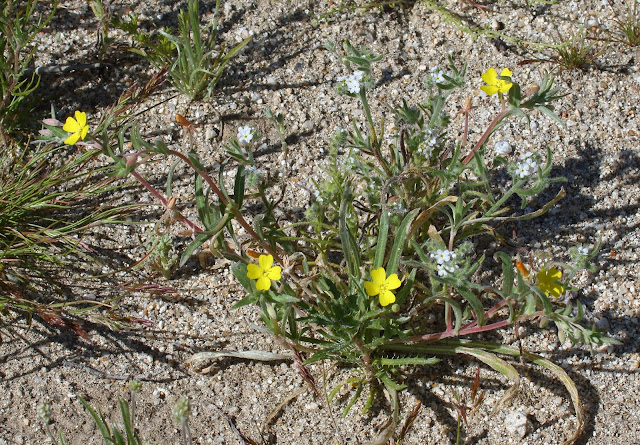 |
| Little Gold Poppy, I think. |
 |
| Desert Chicory. |
 |
| Desert Lily. One of my favorites. |
The lovely Desert Lilies were not blooming yet. I saw only 3 that had open flowers. I did see hundreds of these sand-loving flowers with buds. They needed another week of warmer weather, I guess.
 |
| Barely 3 inches tall, the Popcorn Flower carpets the desert, often under the taller flowers. |
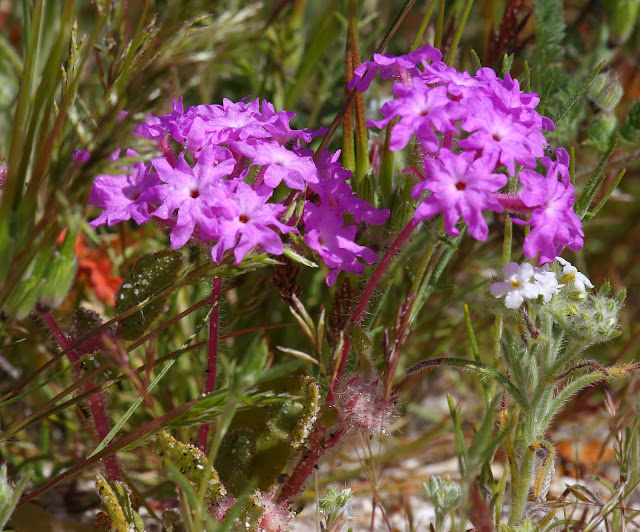 |
| Though smaller, the Sand Verbena is one of the major flowers of Anza-Borrego. |
 |
| Wildflowers: yellow Desert Dandelions and purple Wild Heliotropes with a few white Desert Chicory.
|
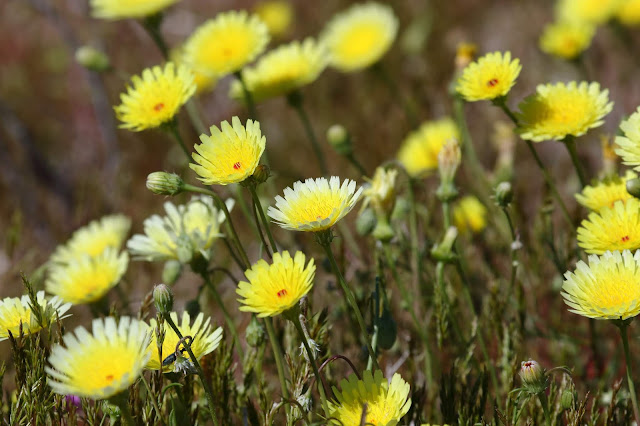 |
| Desert Dandelion |
 |
| Sand Verbena |
There is another species of verbena that grows on the sand dunes of the ocean beaches.
 |
Sand Verbena and Desert Dandelion tower over the Popcorn Flower.
All grow out of the thick spring grass in the Anza-Borrego Desert.
|
 |
| Tall Arizona Lupines were only seen on the side of the road near Truckhaven. |
 |
| A Barrel Cactus flowers near Vallecito County Park. |
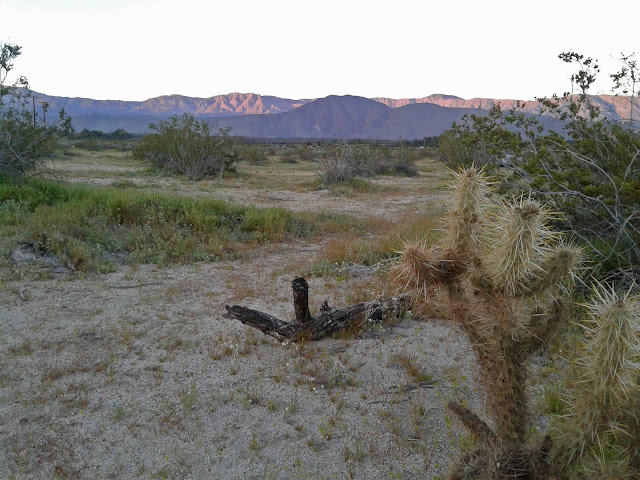 |
| The sun sets behind the western mountains as Marlene and I take a late afternoon walk in Borrego Springs, California. |
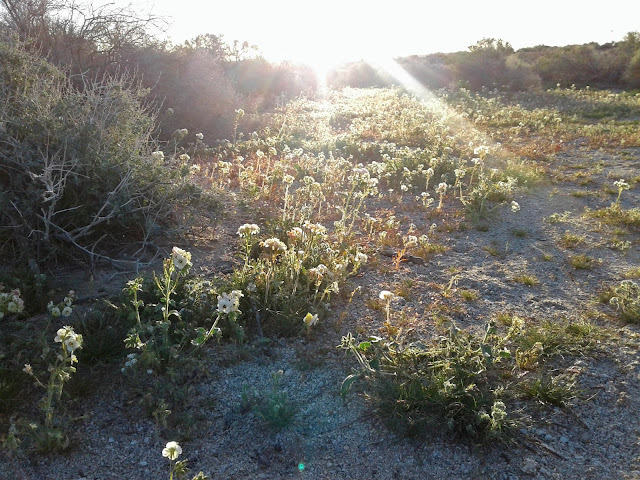 |
| A carpet of Brown-eyed Primrose on sandy soil catches the sunrise at the Borrego Springs waste treatment plant. |
 |
The large Dune Evening Primrose favors sandy soil.
Some Little Gold Poppies peek out.
|
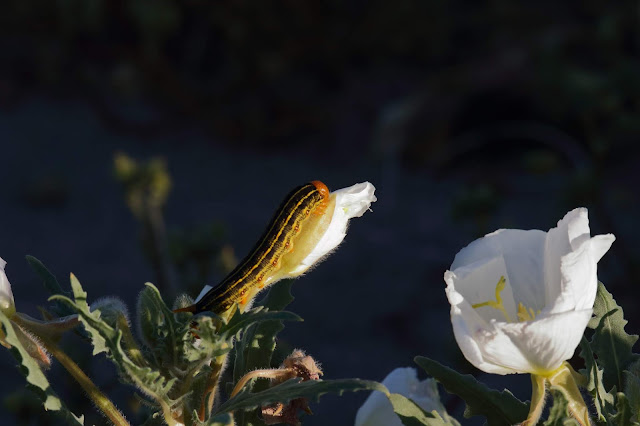 |
| The 3-inch long caterpillar of the Sphynx Moth gorges on the Dune Evening Primrose. |
I spent Sunday evening with a group counting migrant Swainson's Hawks going to roost. Unfortunately, it was a disappointing show. About 70 hawks were circling around very high to the north over Henderson Canyon Road about 5:30 PM. They disappeared for over an hour, then came back, but never approached near the Date Farm evening count site. I couldn't even get a distant photo.
Hal Cohen was leading the volunteer group. The flowers bring the Sphynx Moths, which lay eggs and soon the finger-sized caterpillars are munching on the flowers. Those juicy morsels in turn are eaten by the Swainson's Hawks which may only stay a day or two before continuing north to their breeding grounds in the interior Mountain West. The hawks winter in Argentina and migrate in large flocks of hundreds. During most of the year they eat large grasshoppers, but during a few weeks in spring these Sphynx Moth caterpillars are favored.
Visit the
Borrego Valley Hawkwatch blog.
 |
| Sand Verbena near Truckhaven. |
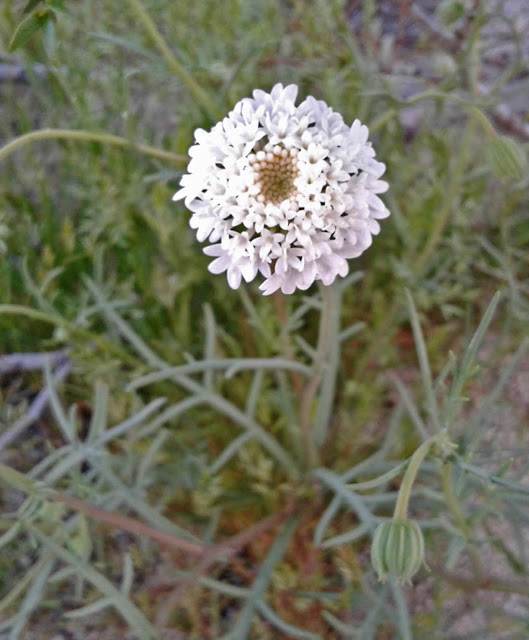 |
| This must be the Fremont's Pincushion. |
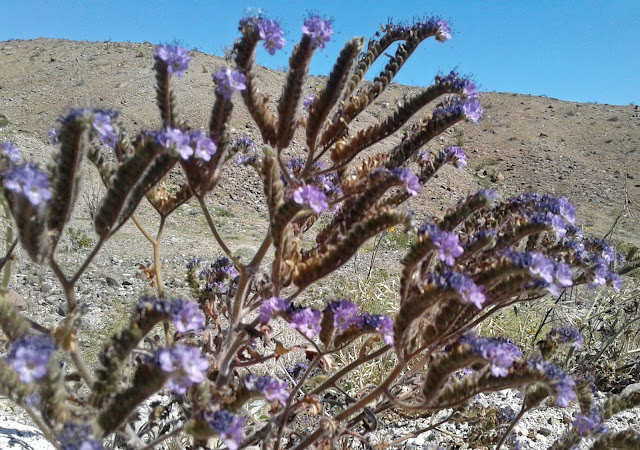 |
| If I've got this right, this is a Scorpionweed, also known as Notch-leaved Phacelia, near Truckhaven. |
 |
| If I've got this right, this is Wild Heliotrope. |
 |
| Wildflowers at Anza-Borrego Desert. |
 |
| Sand Verbena and Desert Sunflower on Henderson Canyon Road. |
Flowers and plants pictured in this article:
Arizona Lupine
Lupinus arizonicus
Barrel Cactus
Ferocactus cylindraceus
Brittlebush
Encelia farinosa
Brown-eyed Primrose
Camissonia claviformis
Desert Chicory
Rafinesquia neomexicana
Desert Dandelion
Malocothrix glabrata
Desert Lily
Hesperocallis undulata
Desert Sunflower
Geraea canescens
Dune Evening Primrose
Oenothera deltoides
Fremont's Pincushion
Chaenactis fremontii
Little Gold Poppy
Eschscholzia minutiflora
Notch-leaved Phacelia (Scorpionweed)
Phacelia crenulata
Popcorn Flower
Cryptantha angustifolia
Sand Verbena
Abronia villosa
Wild Heliotrope
Phacelia distans








